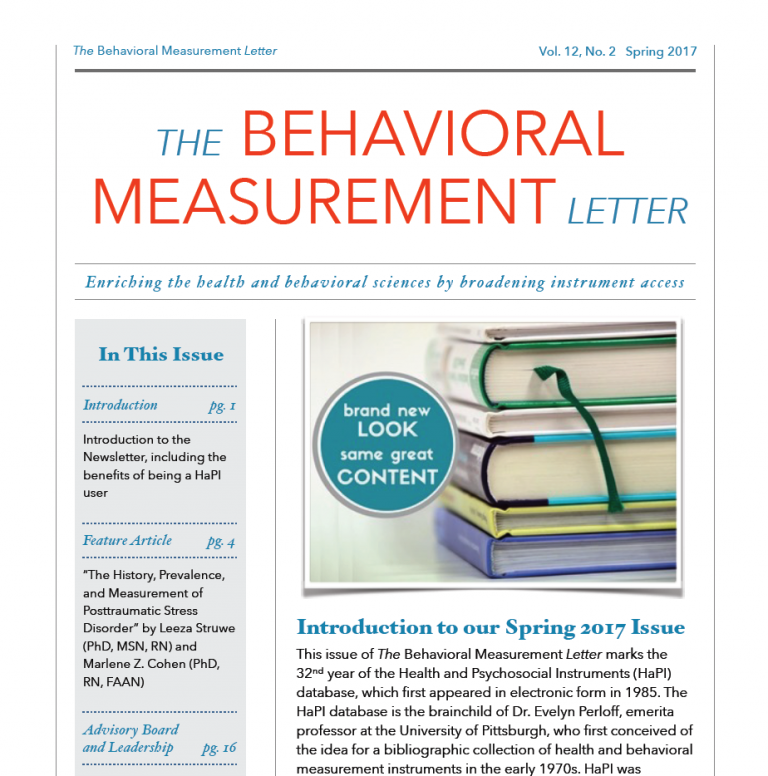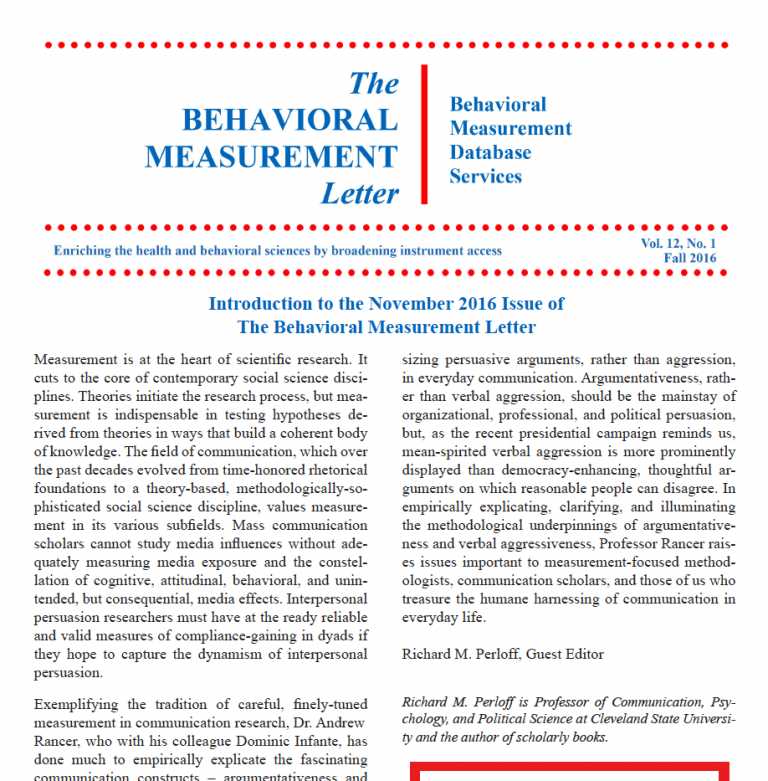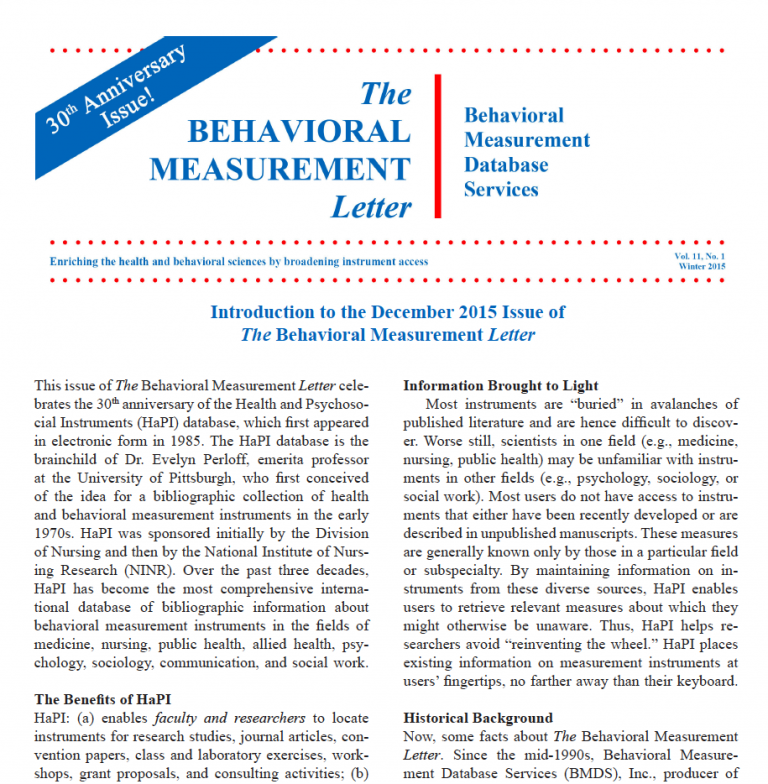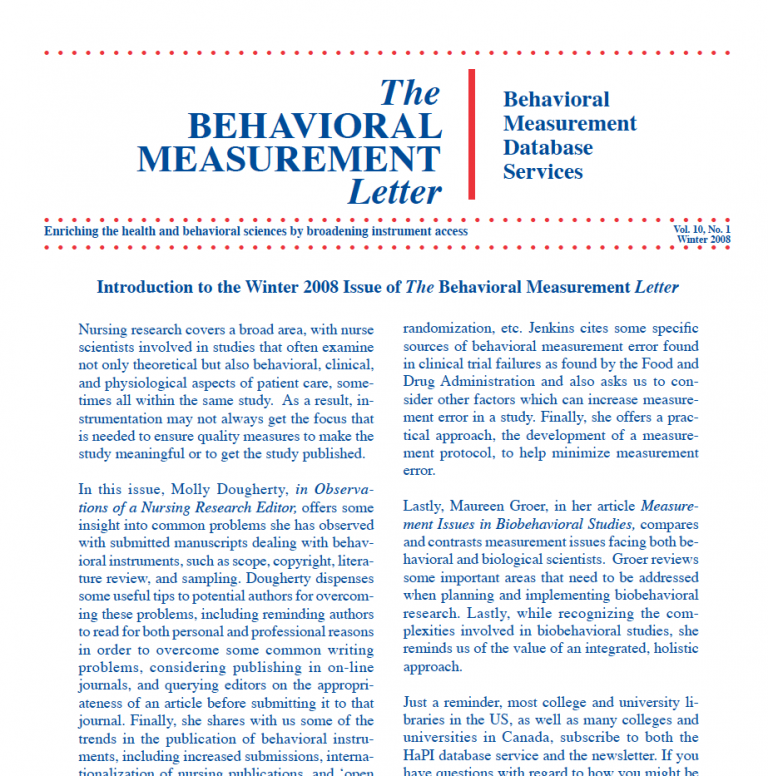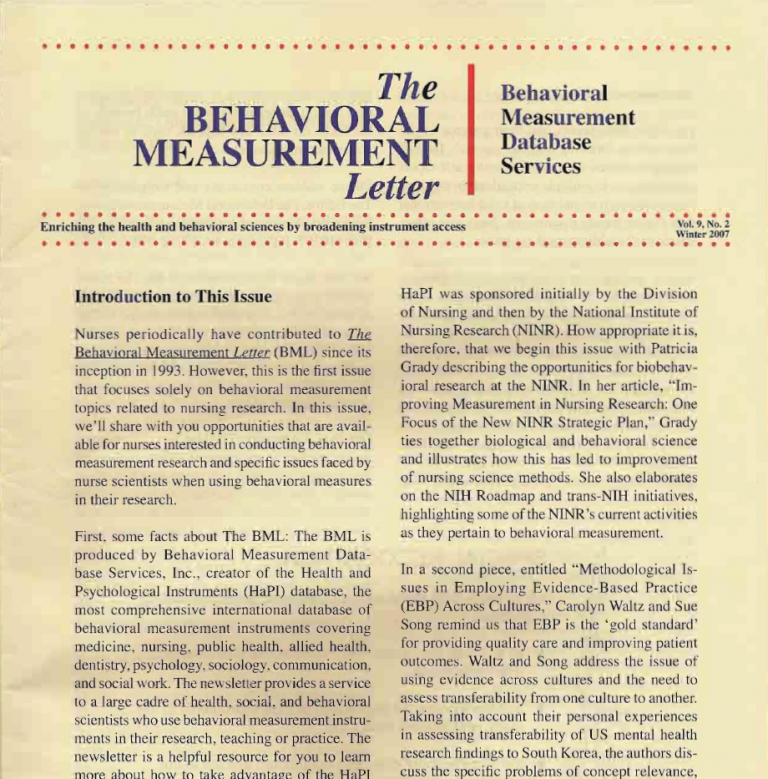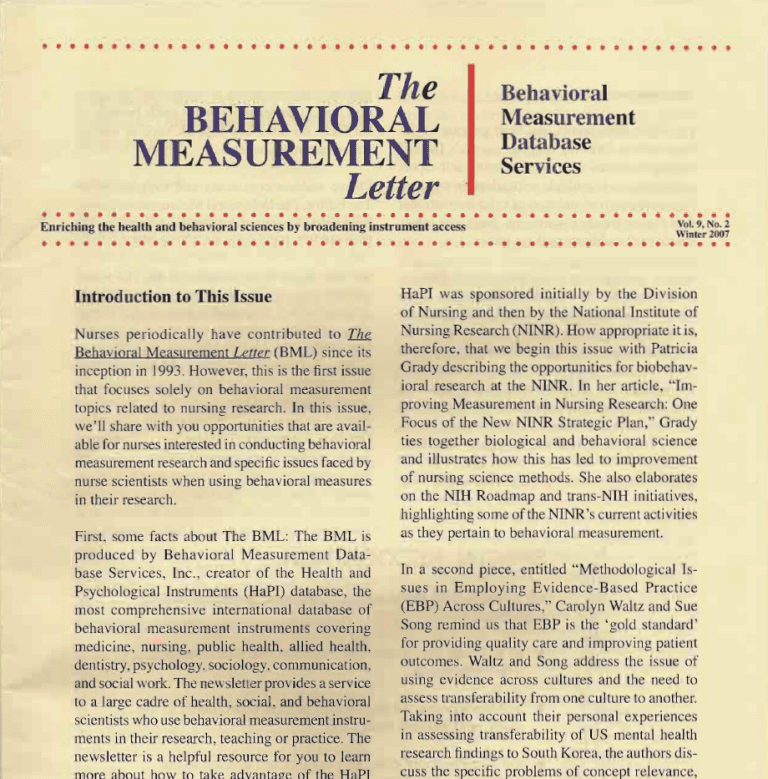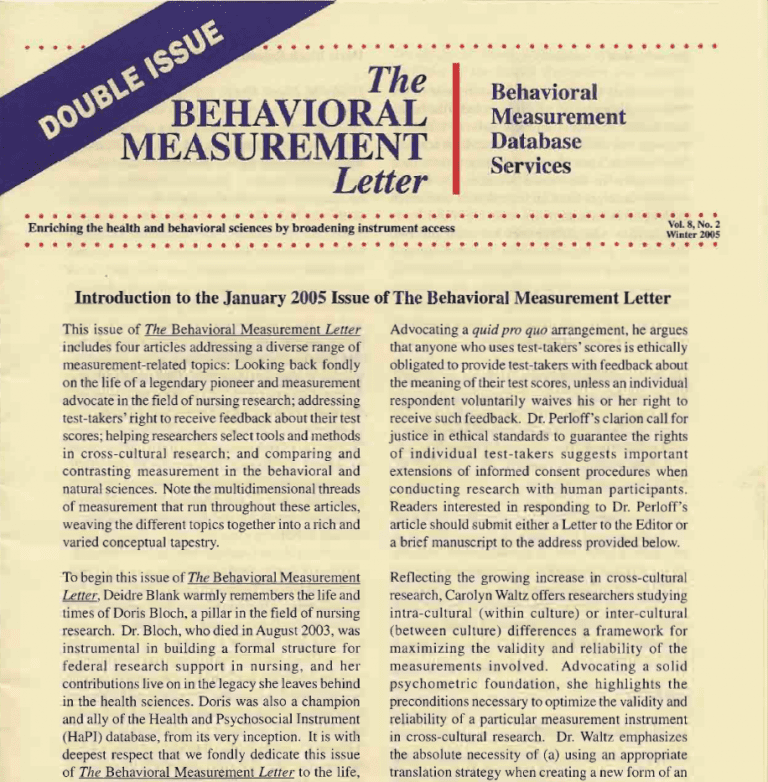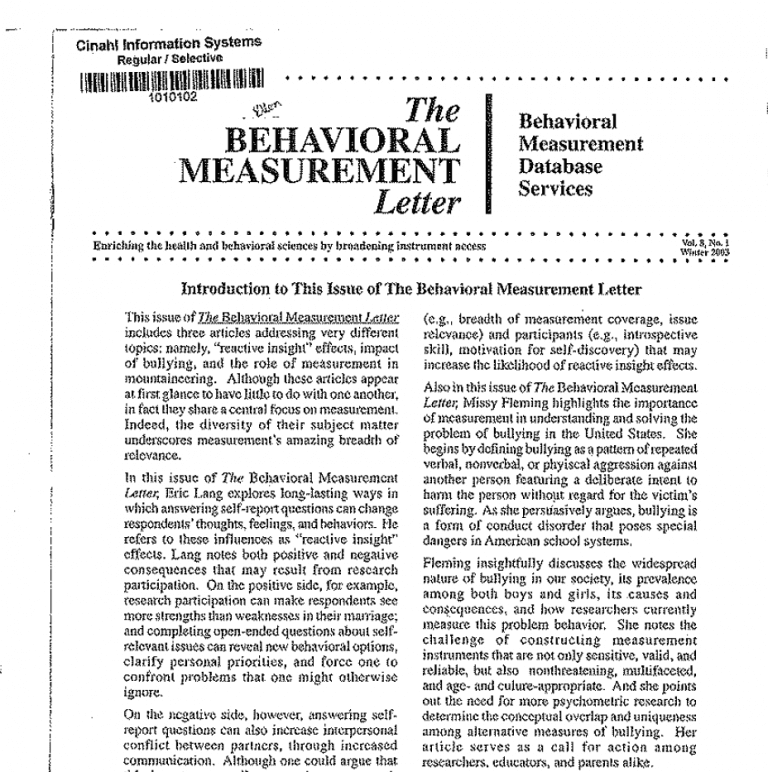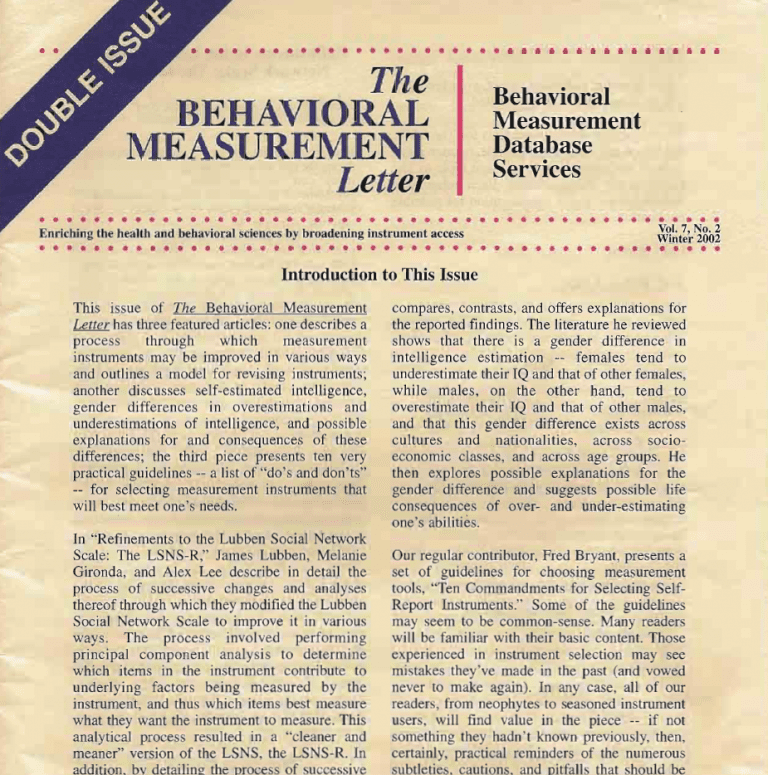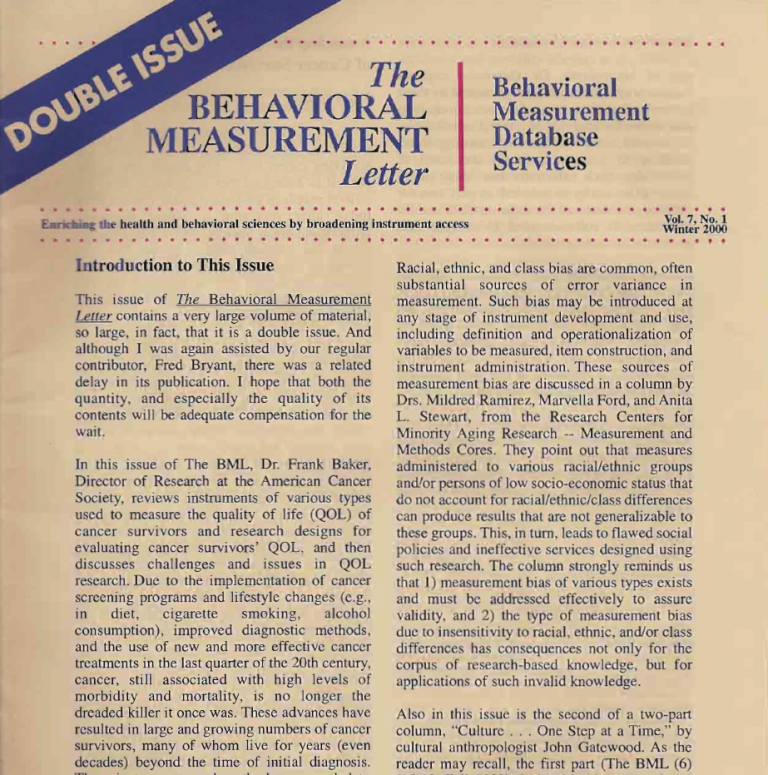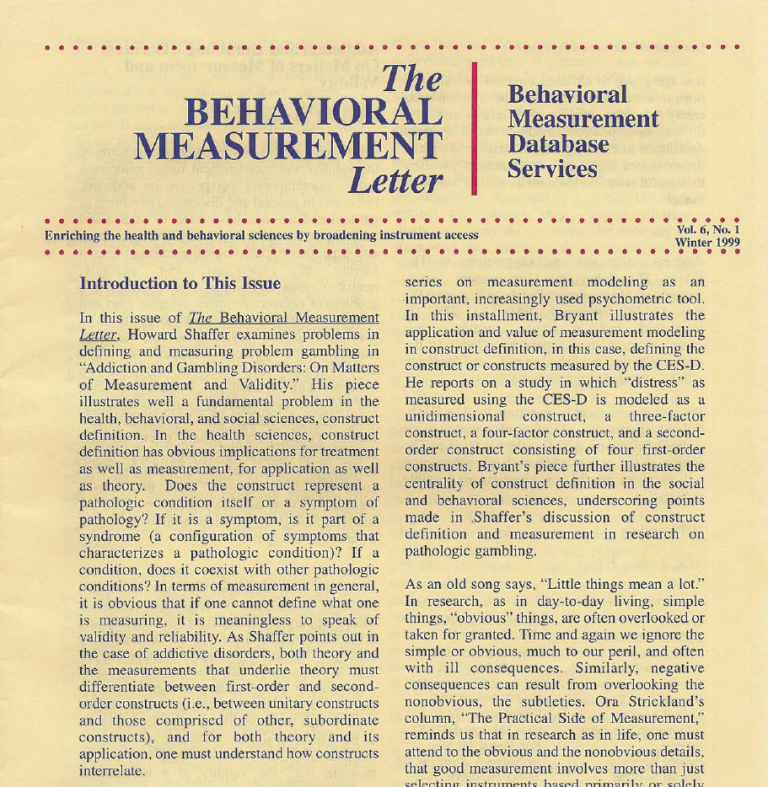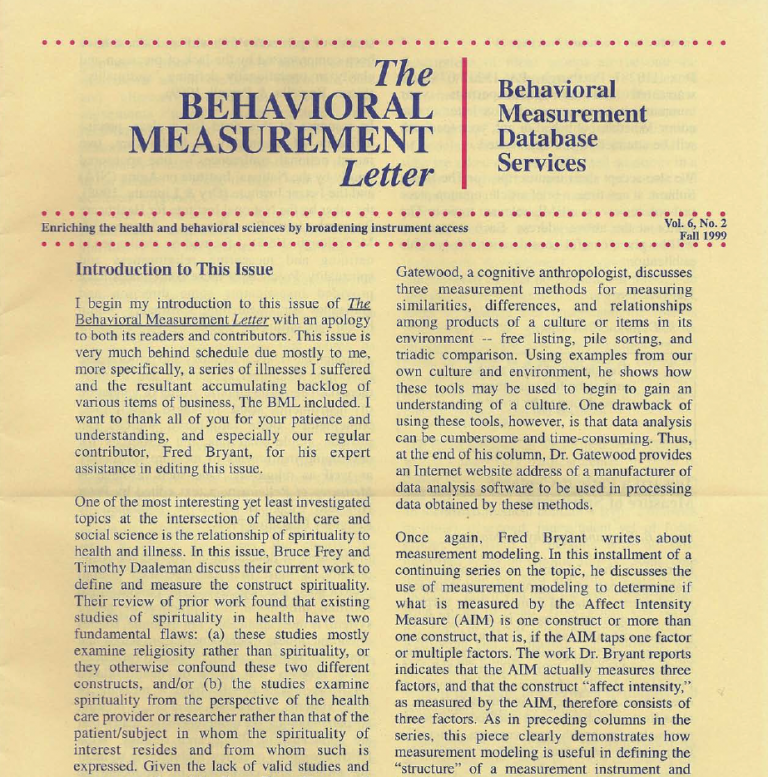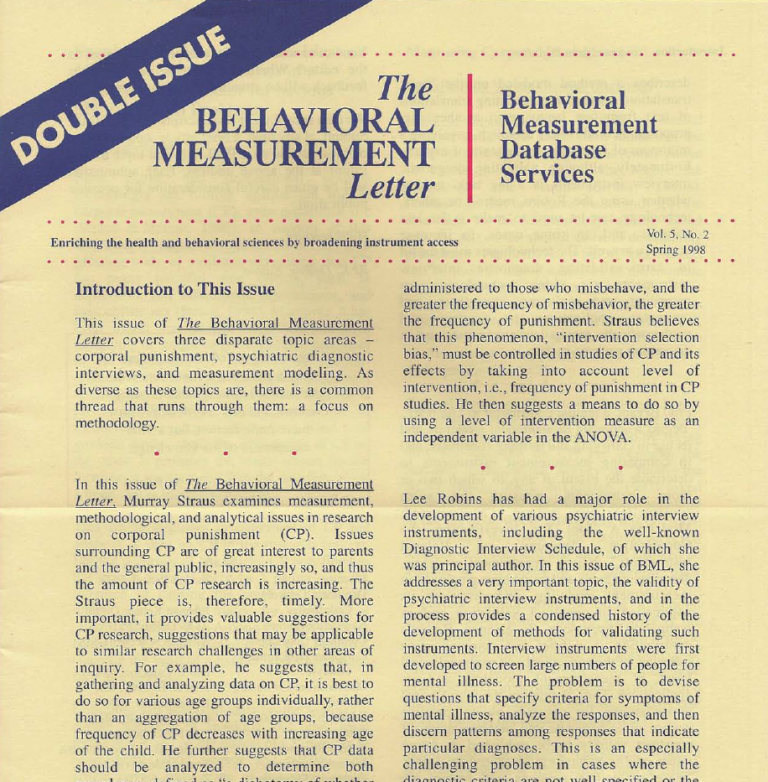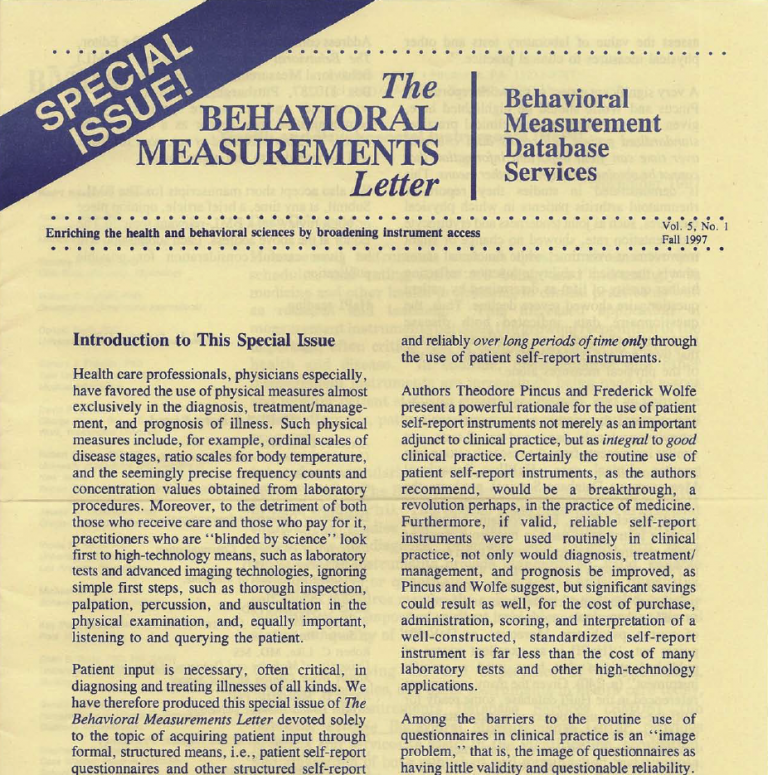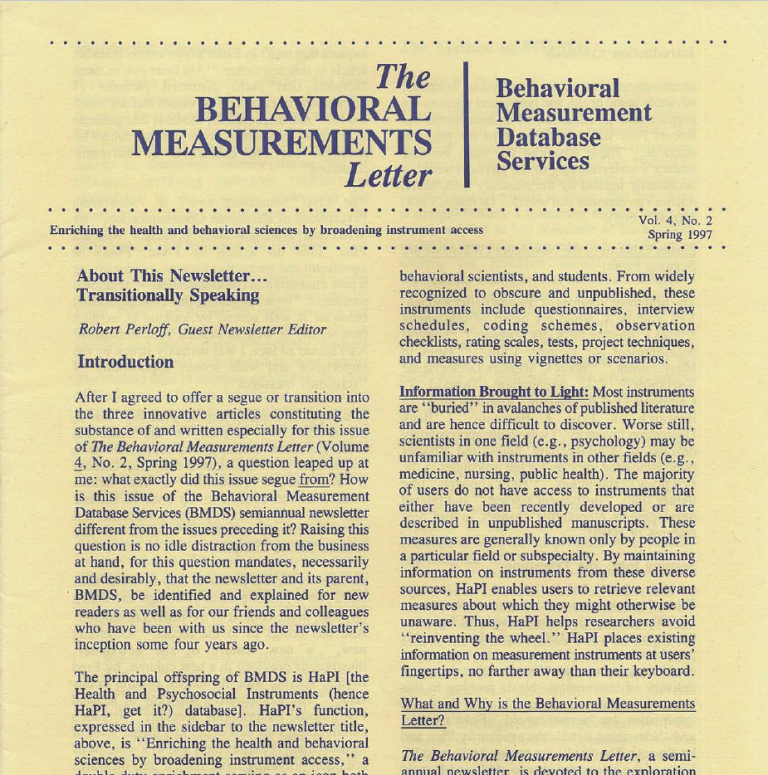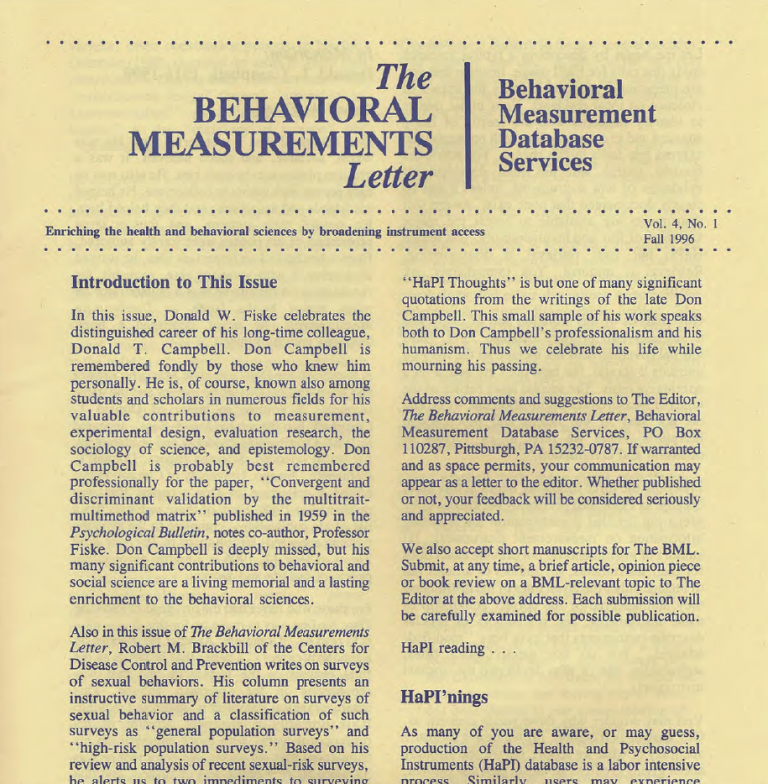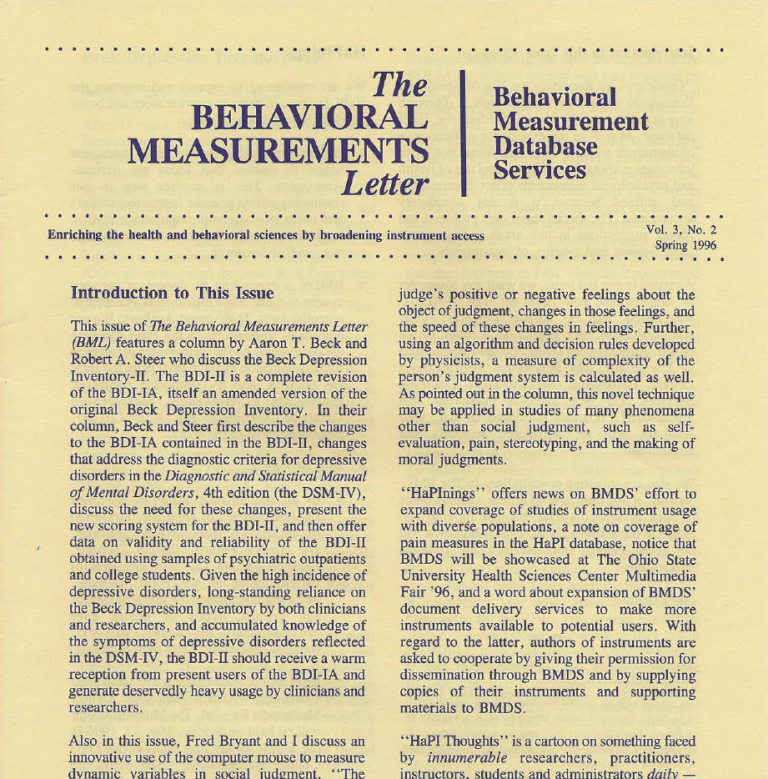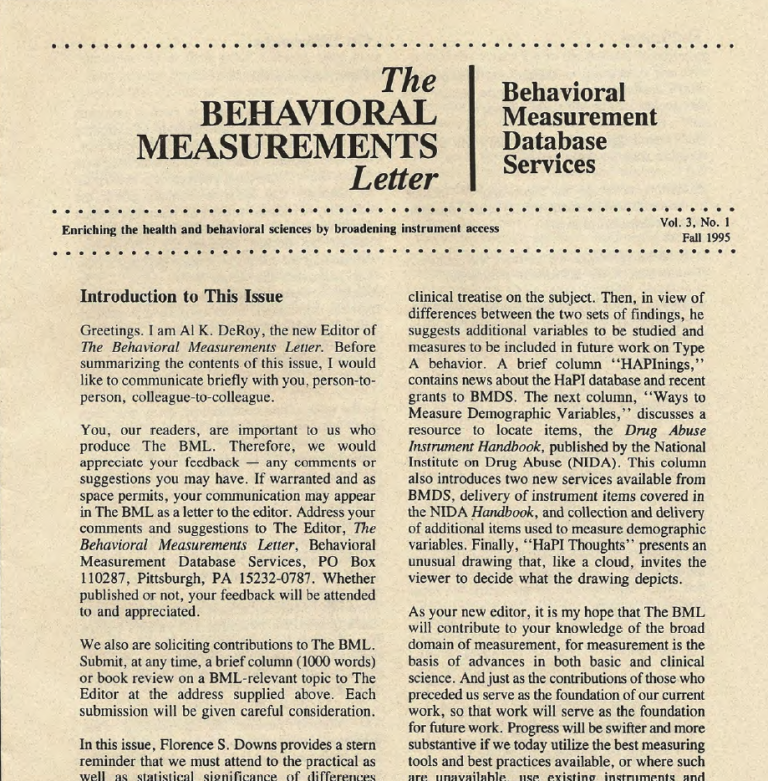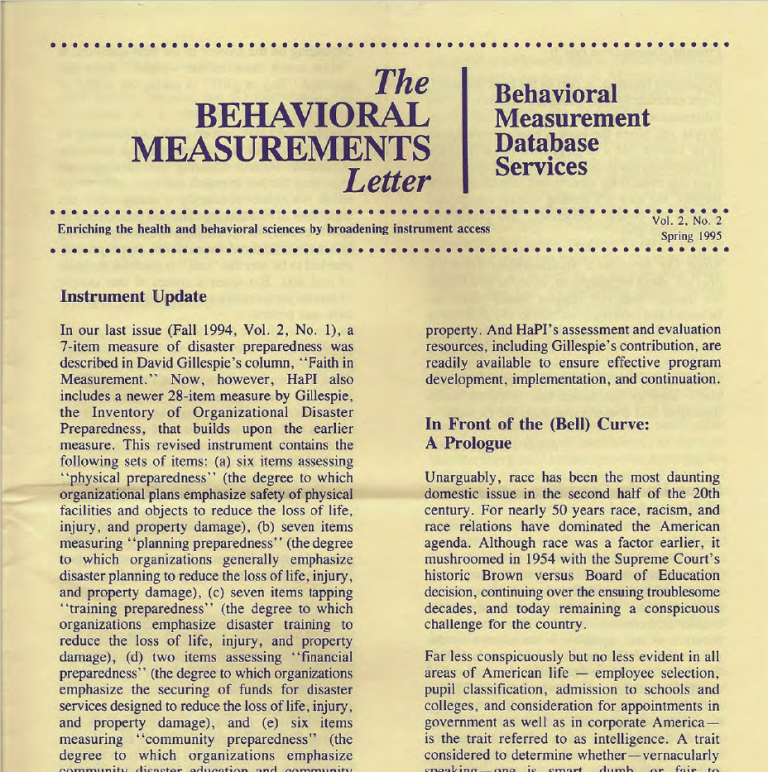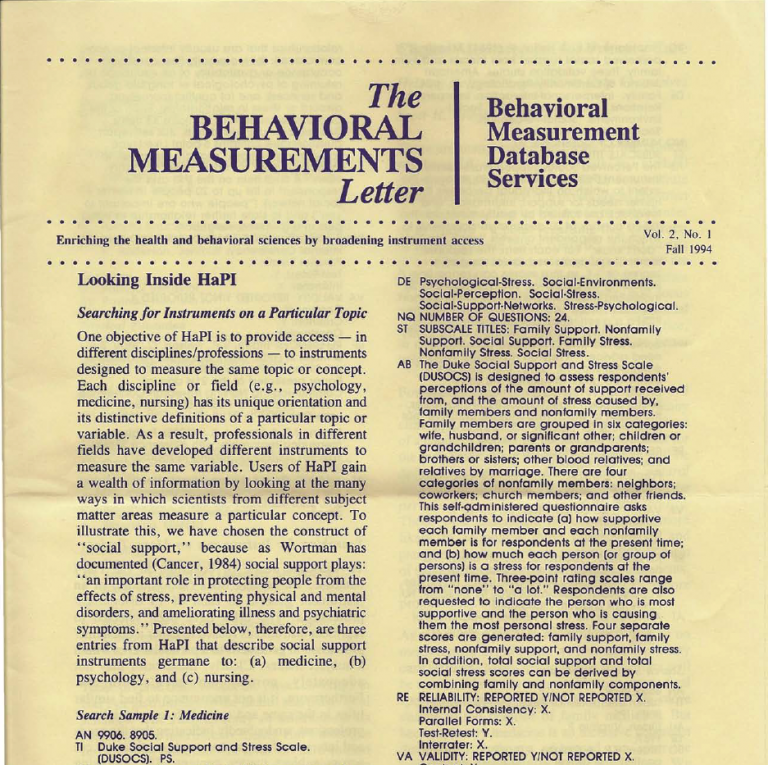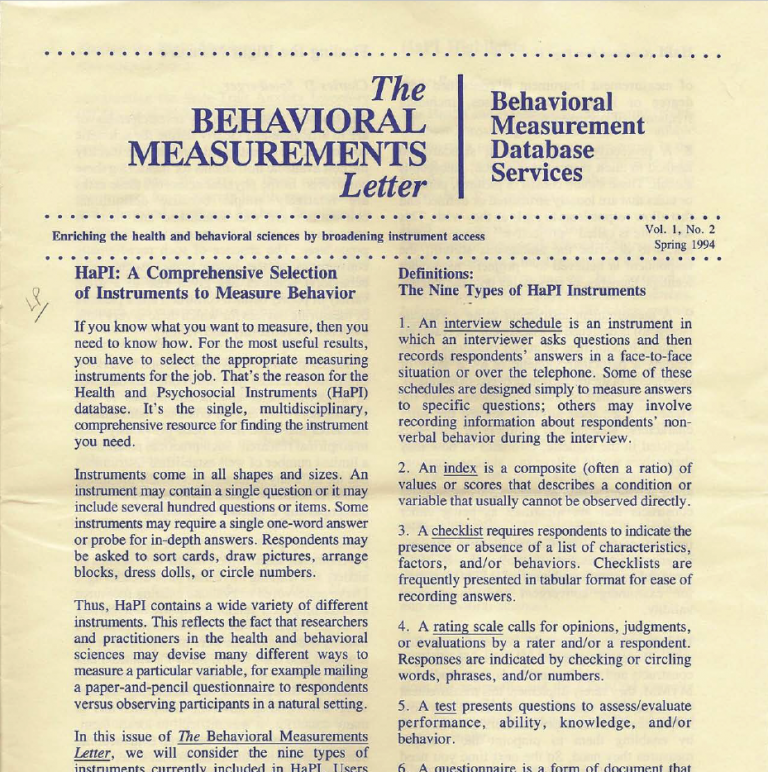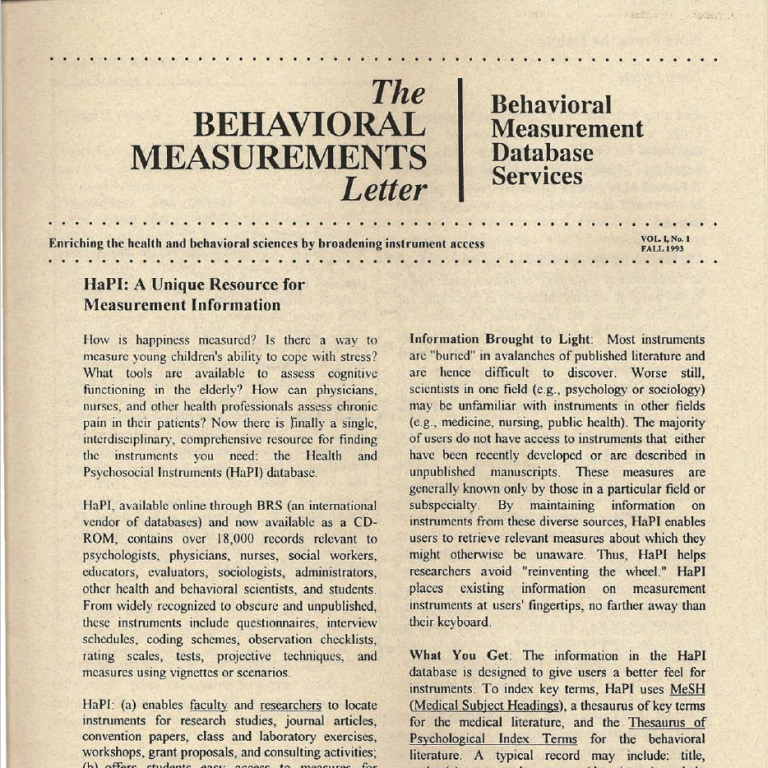Vol. 5, No. 1: Fall 1997
Introduction to This Special Issue
Health care professionals, physicians especially, have favored the use of physical measures almost exclusively in the diagnosis, treatment/management, and prognosis of illness. Such physical measures include, for example, ordinal scales of disease stages, ratio scales for body temperature, and the seemingly precise frequency counts and concentration values obtained from laboratory procedures. Moreover, to the detriment of both those who receive care and those who pay for it, practitioners who are “blinded by science” look first to high-technology means, such as laboratory tests and advanced imaging technologies, ignoring simple first steps, such as thorough inspection, palpation, percussion, and auscultation in the physical examination, and, equally important, listening to and querying the patient.
Patient input is necessary, often critical, in diagnosing and treating illnesses of all kinds. We have therefore produced this special issue of The Behavioral Measurements Letter devoted solely to the topic of acquiring patient input through formal, structured means, i.e., patient self-report questionnaires and other structured self-report instruments. Indeed, with increased emphasis by many health professionals on listening to patients, questionnaires provide a more formal, highly valid and reliable vehicle through which to obtain patient input than the individualized, unstructured interview. Patient questionnaires provide standardization and structure to quantitative as well as qualitative queries. And, as discussed in our featured article, changes in important patient variables, such as pain, functioning, and psychosocial distress, can be documented validly and reliably over long periods of time only through the use of patient self-report instruments.
Authors Theodore Pincus and Frederick Wolfe present a powerful rationale for the use of patient self-report instruments not merely as an important adjunct to clinical practice, but as integral to good clinical practice. Certainly the routine use of patient self-report instruments, as the authors recommend, would be a breakthrough, a revolution perhaps, in the practice of medicine. Furthermore, if valid, reliable self-report instruments were used routinely in clinical practice, not only would diagnosis, treatment/ management, and prognosis be improved, as Pincus and Wolfe suggest, but significant savings could result as well, for the cost of purchase, administration, scoring, and interpretation of a well-constructed, standardized self-report instrument is far less than the cost of many laboratory tests and other high-technology applications.
Among the barriers to the routine use of questionnaires in clinical practice is an “image problem,” that is, the image of questionnaires as having little validity and questionable reliability. Conversely, the image of high-technology methods, such as laboratory tests and advanced imaging methods, is one of unquestioned validity and reliability, for after all, these are products of the same hard science and technology that put men on the moon and computers in our laps. Pincus and Wolfe note that these images do not accurately reflect reality. As they point out, “the criteria used to assess the validity and reliability of self-report instruments are usually applied more rigorously than in the case of criteria used to assess the value of laboratory tests and other physical measures to clinical practice.”
A very significant aspect of the work reported by Pincus and Wolfe should be highlighted here, given its importance to good clinical practice: standardized patient self-report data collected over time can yield important information that cannot be obtained through any other means. This is demonstrated in studies they report of rheumatoid arthritis patients in which physical measures, such as joint tenderness and erythrocyte sedimentation rate, showed no change or slight improvement over time, while functional status (that is, the patient’s ability to function, reflecting his/her quality of life) as determined by patient questionnaire showed severe decline. Thus, the questionnaire data indicated both disease progression and quality of life effects, findings that were not and could not be made through use of the physical measures alone.
The article by Pincus and Wolfe clearly demonstrates the need to move questionnaires, interview protocols, paper-and-pencil tests, and similar instruments from the research setting into routine clinical care. HaPIly, Behavioral Measurements Database Services produces the Health and Psychosocial Instruments database to facilitate such efforts. HaPI contains records on existing instruments used in numerous areas of health research and practice, among them nursing, physical therapy, psychology, and medical specialties such as cardiology, neurology, pulmonary medicine, critical care, and oncology as well as rheumatology, physical medicine and, of course, psychiatry. Moreover, as DeVellis points out, “[HaPI) is an excellent source of published studies that have used a specific instrument” (p. 240). Given the many instruments referenced in the HaPI database, some ready for “off-the-shelf” use, others at various stages of development, HaPI is the largest, most comprehensive source of instruments for immediate clinical use and for starting points in efforts to refine existing instruments and develop new ones.
References
DeVellis, R. F. (1996). A consumer’s guide to finding, evaluating, and reporting on measurement instruments. Arthritis Care and Research, 9, 239-245.
Address comments and suggestions to The Editor, The Behavioral Measurements Letter, (BML) Behavioral Measurement Database Services, PO Box 110287, Pittsburgh, PA 15232-0787. If warranted and as space permits, your communication may appear as a letter to the editor. Whether published or not, your feedback will be attended to and appreciated.
We also accept short manuscripts for The BML. Submit, at any time, a brief article, opinion piece or book review on a BML-relevant topic to The Editor at the above address. Each submission will be given careful consideration for possible publication.
HaPI reading…
Al K. DeRoy, Editor
Patient Self-Report Questionnaires as Integral to Clinical Care
Theodore Pincus, MD and Frederick Wolfe, MD
Patient self-report questionnaires have gained substantial prominence in medical research over the last few decades (Fries, Spitz, Kraines, & Holman, 1980; Meenan, Gertman, & Mason, 1980; Pincus, 1995; Pincus & Wolfe, 1995; Ware & Sherbourne, 1992; Wolfe, 1995). Self-report questionnaires allow quantitative assessment of many of the primary concerns, such as pain, fatigue, decrease in functionality, or psychological distress that lead a person to consult a health professional. These concerns cannot be measured directly by physical methods such as laboratory tests, radiographs, EKGs, and other high-technology applications. Moreover, changes in such concerns over time can be documented only through repeated administration of self-report instruments, such as questionnaires and structured interview protocols (Pincus, 1996).
Despite the contribution of patient questionnaires to clinical research studies, questionnaires remain generally regarded as adjunct, rather than integral, to patient care. This phenomenon may be explained in large part by continuing dominance of the “biomedical model” in clinical care (Engel, 1977). The biomedical model dictates that the most critical information in assessing, monitoring, and predicting outcomes of somatic diseases is derived from “objective” laboratory tests and other high-technology methods, rather than from “subjective” information provided by the patient (Weed, 1968). In the classic medical model, mind and body are regarded as independent in somatic diseases.
The biomedical model is most effective in the assessment, management and prognosis of acute diseases, and acute events within the course of chronic disease, particularly in in-patient, acute-care hospitals, the primary setting of most medical education and research. But in chronic diseases, the primary health problem in the population (Rice & Feldman, 1983), the biomedical model is not nearly as successful as in acute diseases (DeFriese, Woomert, Guild, Steckler, & Konard, 1989; Engel, 1977; Pincus & Callahan, 1995a; Sobel, 1995). To assess, manage, and predict outcomes over the course of chronic illness-2, 5, 10 or more years-it is necessary to quantify patient variables that cannot be measured by laboratory tests and physical devices. Moreover, one study indicated fewer than 20 percent of symptoms seen in a medical clinic were explained by any somatic data and thus amenable to standard medical intervention (Kroenke & Mangelsdorff, 1989). These observations suggest that patient input must be obtained and quantified just as information is obtained now from laboratory tests and other physical means as a matter of course.
Health professionals have an intellectual and ethical responsibility to determine whether interventions are of value to their patients. But in chronic conditions, because of the long time interval from baseline to later evaluation, one cannot rely on the memory of the patient or clinician to describe patient status 5, 10 or more years earlier. In our search for better means to monitor and manage our patients with chronic diseases, we found that the best data to assess change in important patient concerns such as functional status, pain and psychological distress, are obtained from patient self-report questionnaires. We also found that patient questionnaire data can be used to monitor and predict disability and other consequences of chronic diseases as effectively as data from high- technology sources. We therefore suggest that health professionals incorporate patient self-report instruments into clinical care just as they do laboratory tests, radiographs, and other physical measures.
The rationale for our approach is derived in large part from studies documenting the value of self-report questionnaires in the assessment, monitoring, and prognosis of individual patients with rheumatoid arthritis. Several self-report questionnaires, such as the Health Assessment Questionnaire (Fries et al., 1980) and the Arthritis Impact Measurement Scales (Meenan et al., 1980), have been shown to provide valid and reliable data. In this regard, it is important to note that the criteria used to assess the validity and reliability of self-report instruments are usually applied more rigorously than in the case of criteria used to assess the value of laboratory tests and other physical measures to clinical care.
The Health Assessment Questionnaire (HAQ) developed by Fries and colleagues at Stanford University includes 20 activities of daily living in eight categories-arising, dressing, eating, walking, hygiene, reach, grip, and other activities, as well as a visual analog pain scale, global scale, and queries concerning use of aids and devices (Fries et al., 1980). The Arthritis Impact Measurement Scales (AIMS), developed by Meenan and colleagues, includes items to measure several “dimensions” of health status, such as mobility, physical activity, dexterity, household activities, anxiety, depression and social activities, as well as items to assess activities of daily living and pain (Meenan et al., 1980). The McMaster Patient Preference Disability MACTAR questionnaire, developed by Tugwell and colleagues, provides patients an opportunity to express the relative utility of different activities in their assessment of clinical status. Administration of the MACTAR requires an observer (Tugwell, Bombardier, Buchanan, Goldsmith, Grace, & Hanna, 1987). The CLINHAQ, a derivative of the HAQ developed by Wolfe and colleagues (Wolfe, 1995; Wolfe, Hawley, & Wilson, 1996), includes a pain diagram, anxiety, and depression scales from the AIMS questionnaire (Wolfe & Hawley, 1993), review of medications, and other areas of inquiry (Wolfe & Pincus, 1995). The modified HAQ (MHAQ) includes 8, rather than 20, activities of daily living, but incorporates into a two-page format other data not found in the HAQ, including measures of fatigue and psychological distress, and review of medications (Callahan, Smith, & Pincus, 1989; Pincus, 1995; Pincus, Callahan, Brooks, Fuchs, Olsen, & Kaye, 1989; Pincus, Summey, Sovaci, Wallston, & Hummon, 1983; Wolfe & Pincus, 1995). Each of these questionnaires is suitable for research and clinical use, although the HAQ and its derivatives, the CLINHAQ and the MHAQ, are more easily administered than the others and thus may be more suitable in routine clinical care.
We and several other rheumatologists routinely use patient questionnaires as an integral part of clinical management. Patients complete a questionnaire in the waiting room at each visit and the resultant data are entered into a database. Changes are analyzed and monitored over time to determine responses to therapy and clinical outcomes.
Given our experience of the value of self-report instruments in clinical rheumatology, we believe that patient questionnaires might be as valuable in the assessment, management, and prognosis of diseases of other organ systems. Therefore, a strong rationale for the routine use of patient self-report instruments as integral, rather than adjunct, to patient care is summarized below.
- Measures from patient questionnaires correlate significantly with measures obtained from the physical examination, radiographs, and laboratory tests (Pincus et al., 1989; Wolfe, Kleinhoksel, Cathey, Hawley, Spitz, & Fries, 1988). Moreover, self-report measures appear to provide the best representation of all measures used to assess patient status (Pincus et al., 1989), including measures obtained from high-technology devices.
- In clinical studies, including randomized controlled clinical trials, questionnaire data document changes in clinical status from one visit to the next as effectively as physical measures (Wolfe & Pincus, 1995).
- Questionnaire data are more effective than any other available data in documenting functional declines over 5 to 10 years (Callahan, Cordray, Wells, & Pincus, 1996; Hawley & Wolfe, 1992; Pincus, Callahan, Sale, Brooks, Payne, & Vaughn, 1984; Wolfe, Hawley, & Cathey, 1991). In one study, more than 80 percent of patients with rheumatoid arthritis monitored between 1973 and 1982 experienced serious functional declines. Morning stiffness was improved in half these patients over the nine years, suggesting that inflammatory activity was either stable or decreasing (Pincus et al., 1984). This observation has led to recognition that measures of long-term damage, such as functional status, may show serious progression of the disease in the same patients whose inflammatory indicators may be stable or improved (Callahan, Pincus, Huston, Brooks, Nance, & Kaye, 1997; Hawley & Wolfe, 1992).
Evidence of improvement in activity measures over long periods of time while patients experience disease progression is illustrated in the study of Hawley and Wolfe (1992). No change or even slight improvement over 5 and 10 years was seen in measures of global severity, joint tenderness, morning stiffness, erythrocyte sedimentation rate (ESR), and hemoglobin, while severe declines were seen in functional status measured by the HAQ (see Figure 1). Thus, if physical data alone were relied upon, as is traditionally the case, these patients would have been regarded as unchanged or even slightly improved over 5 and 10 years. Data from the HAQ, however, provide conclusive evidence of disease progression.
- Questionnaire data have been shown to predict severe outcomes, including work disability and premature death, over long periods more effectively than data from other sources. For example, the most obvious poor outcome in rheumatoid arthritis, premature death, is predicted more effectively by patient questionnaire data than by physical methods such as laboratory tests and radiographs (Callahan et al., 1997; Pincus, 1995; Pincus, Brooks, & Callahan, 1994; Pincus, Callahan, & Vaughn, 1987; Wolfe, Mitchell, & Sibley, 1994). Moreover, the predictive power of the questionnaire data was similar whether 70, 20, or only 8 activities were queried to determine functional status, indicating the value of 2-4 page questionnaires and that elaborate self-report instruments are not needed in clinical care (Pincus et al., 1994).
A functional status questionnaire is also the most effective measure to identify work disability in patients with rheumatoid arthritis (Callahan, Bloch, & Pincus, 1992). More than 50 percent of patients suffering rheumatoid arthritis for longer than 10 years become unable to work and receive disability benefits (Pincus et al., 1984; Yelin, Meenan, Nevitt, & Epstein, 1980). One study showed that rheumatoid arthritis patients who were receiving work disability payments had more extensive radiographic and joint abnormalities than patients who were working full-time. However, of all measures analyzed, including those physical and laboratory measures routinely queried by the Social Security Administration, functional status as measured by self-report questionnaire was the best discriminator between patients who were working and those receiving disability payments (Callahan et al., 1992).
- Self-report questionnaires provide clinically important information on functional limitations, pain, fatigue, and psychological distress in diseases other than rheumatoid arthritis, such as systemic lupus erythematosus, scleroderma, osteoarthritis, and fibromyalgia (Callahan et al., 1989; Callahan & Pincus, 1990a; Callahan & Pincus, 1990b; Engle, Callahan, Pincus, & Hochberg, 1990).
- Self-report questionnaires may be useful in diagnosis as well as in assessment, prognosis, and monitoring of patient status. In an analysis of data on patients with various rheumatic diseases, scores for functional limitation were highest (indicating the most limitations) in those with rheumatoid arthritis, while scores for pain, global status, and psychological distress were highest in patients with fibromyalgia (Callahan et al., 1989). (Fibromyalgia is a syndrome characterized by diffuse noninflammatory musculoskeletal pain in contrast to inflammatory conditions such as rheumatoid arthritis.) Moreover, a ratio of the score for difficulty in performance of activities of daily living (D-ADL) versus a pain visual analog scale score (P-VAS) higher than five was found to be characteristic of patients with fibromyalgia versus those with rheumatoid arthritis (Callahan & Pincus, 1990a).
The above provides a persuasive scientific case for the value of patient questionnaires in the diagnosis, assessment, treatment, management, and prognosis of chronic diseases. Given these findings, and the responsibility of health professionals to do what is best for their patients, it is now time to incorporate the use of existing valid, reliable self-report questionnaires into clinical care as a matter of routine. Health professionals must work to refine and improve these instruments, and to assess their value in diagnosis, prognosis, monitoring, and characterizing outcomes. Similarly, more resources must be devoted to research and development of clinical applications of self-report instruments for patient care.
References
Callahan, L. F., Bloch, D. A., & Pincus, T. (1992). Identification of work disability in rheumatoid arthritis: Physical, radiographic, and laboratory variables do not add explanatory power to demographic and functional variables. Journal of Clinical Epidemiology, 45, 127-138.
Callahan, L. F., Cordray, D. S., Wells, G., & Pincus T. (1996). Formal education and five-year mortality in rheumatoid arthritis: Mediation by helplessness scale scores. Arthritis Care and Research, 9, 463-472.
Callahan, L. F., & Pincus, T. (1990b). Associations between clinical status questionnaire scores and formal education level in systemic lupus erythematosus. Arthritis and Rheumatism, 33, 407-411.
Callahan, L. F., & Pincus, T. (1990a). The P-VAS/ D-ADL ratio: A clue from a self-report questionnaire to distinguish rheumatoid arthritis from noninflammatory diffuse musculoskeletal pain. Arthritis and Rheumatism, 33, 1317-1322.
Callahan, L. F., Pincus, T., Huston, J. W., III, Brooks, R. H., Nance, E. P., Jr., & Kaye J. J. (1997). Measures of activity and damage in rheumatoid arthritis: Depiction of changes and prediction of mortality over five years. Arthritis Care and Research, 10, 381-394.
Callahan, L. F., Smith, W. J., & Pincus, T. (1989). Self-report questionnaires in five rheumatic diseases: comparisons of health status constructs and associations with formal education level. Arthritis Care and Research, 2, 122-131.
DeFriese, G. H., Woomert, A., Guild, P. A., Steckler, A. B., & Konard, T. R. (1989). From activated patient to pacified activist: A study of the self-care movement in the United States. Social Science & Medicine, 29, 195-204.
Engel, G. L. (1977). The need for a new medical model: A challenge for biomedicine. Science, 196, 129-136.
Engle, E. W., Callahan, L. F., Pincus, T., & Hochberg, M. C. (1990). Learned helplessness in systemic lupus erythematosus: Analysis using the Rheumatology Attitudes Index. Arthritis and Rheumatism, 33, 281-286.
Fries, J. F., Spitz, P., Kraines, R. G., & Holman, H. R. (1980). Measurement of patient outcome in arthritis. Arthritis and Rheumatism, 23, 137-145.
Hawley, D. J., & Wolfe, F. (1992). Sensitivity to change of the Health Assessment Questionnaire (HAQ) and other clinical and health status measures in rheumatoid arthritis: Results of short term clinical trials and observational studies versus long term observational studies. Arthritis Care and Research, 5, 130-136.
Kroenke, K., & Mangelsdorff, A. D. (1989). Common symptoms in ambulatory care: Incidence, evaluation, therapy, and outcome. American Journal of Medicine, 86, 262-266.
Meenan, R. F., Gertman, P. M., & Mason, J. H. (1980). Measuring health status in arthritis: The Arthritis Impact Measurement Scales. Arthritis and Rheumatism, 23, 146-152.
Pincus, T. (1995). Why should rheumatologists collect patient self-report questionnaires in routine rheumatologic care? Rheumatic Diseases Clinics of North America, 21, 271-317.
Pincus, T. (1996). Documenting quality management in rheumatic disease: Are patient questionnaires the best (and only) method? Arthritis Care and Research, 9, 339-348.
Pincus T., Brooks, R. H., & Callahan, L. F. (1994). Prediction of long-term mortality in patients with rheumatoid arthritis according to simple questionnaire and joint count measures. Annals of Internal Medicine, 120, 26-34.
Pincus, T., & Callahan, L. F. (1995b). Prognostic markers of activity and damage in rheumatoid arthritis: Why clinical trials and inception cohort studies indicate more favorable outcomes than studies of patients with established diseases. British Journal of Rheumatology, 34, 196-199.
Pincus, T., & Callahan, L. F. (1995a). What explains the association between socioeconomic status and health: Primarily medical access or mind-body variables? Advances, 11, 4-36.
Pincus, T., Callahan, L. F., Brooks, R. H., Fuchs, H. A., Olsen, N. J., & Kaye, J. J. (1989). Self-report questionnaire scores in rheumatoid arthritis compared with traditional physical, radiographic, and laboratory measures. Annals of Internal Medicine, 110, 259-266.
Pincus, T., Callahan, L. F., Sale, W. G., Brooks, A. L., Payne, L. E., & Vaughn, W. K. (1984). Severe functional declines, work disability, and increased mortality in seventy- five rheumatoid arthritis patients studied over nine years. Arthritis and Rheumatism, 27, 864-872.
Pincus, T., Callahan, L. F., & Vaughn, W. K. (1987). Questionnaire, walking time, and button test measures of functional capacity as predictive markers for mortality in rheumatoid arthritis. Journal of Rheumatology, 14, 240-251.
Pincus, T., Summey, J. A., Soraci, S. A., Jr., Wallston, K. A., & Hummon, N. P. (1983). Assessment of patient satisfaction in activities of daily living using a modified Stanford Health Assessment Questionnaire. Arthritis and Rheumatism, 26, 1346-1353.
Rice, D. P., & Feldman, J. J. (1983). Living longer in the United States: Demographic changes and health needs of the elderly. Health and Society, 61, 362-396.
Sobel, D. S. (1995). Rethinking medicine: Improving health outcomes with cost-effective psychosocial interventions. Psychosomatic Medicine, 57, 234-244.
Tugwell, P., Bombardier, C., Buchanan, W. W., Goldsmith, C. H., Grace, E., & Hanna, B. (1987). The MACTAR Patient Preference Disability Questionnaire-An individualized functional priority approach for assessing improvement in physical disability in clinical trials in rheumatoid arthritis. Journal of Rheumatology, 14, 446-451.
Ware, J. E., Jr., & Sherbourne, C.D. (1992). The MOS 36-item Short-Form Health Survey (SF-36): I. Conceptual framework and item selection. Medical Care, 30, 473-481.
Weed, L. L. (1968). Medical records that guide and teach. New England Journal of Medicine, 278, 593-600, 652-57.
Wolfe, F. (1995). Health status questionnaires. Rheumatic Diseases Clinics of North America, 21, 445-464.
Wolfe, F., & Hawley, D. J. (1993). The relationship between clinical activity and depression on rheumatoid arthritis. Journal of Rheumatology, 20, 2032-2037.
Wolfe F., Hawley, D. J., & Cathey, M. A. (1991). The assessment and prediction of functional disability in RA. Journal of Rheumatology, 18, 1298-1306.
Wolfe F., Hawley, D. J., & Wilson, K. (1996). The prevalence and meaning of fatigue in rheumatic disease. Journal of Rheumatology, 23, 1408-1417.
Wolfe, F., Kleinhoksel, S. M., Cathey, M. A., Hawley, D. J., Spitz, P. W., & Fries, J. F. (1988). The clinical value of the Stanford Health Assessment Questionnaire Functional Disability Index in patients with rheumatoid arthritis. Journal of Rheumatology, 15, 1480-1488.
Wolfe F., Mitchell, D. M., Sibley, J. T., et al. (1994). The mortality of rheumatoid arthritis. Arthritis and Rheumatism, 37, 481-494.
Wolfe, F., & Pincus T. (1995). Data collection in the clinic. Rheumatic Diseases Clinics of North America, 21, 321-358.
Yelin, E., Meenan, R., Nevitt, M., & Epstein, W. (1980). Work disability in rheumatoid arthritis: Effects of disease, social, and work factors. Annals of Internal Medicine, 93, 551-556.
Theodore Pincus, MD, is Professor of Medicine and Microbiology at Vanderbilt University Medical Center. His earlier research included development of a radio-immunoassay method to measure DNA antibodies in systemic lupus erythematosus, description of specific host genetic controls in experimental endogenous retrovirus infection, and characterization of “criterion contamination” in interpreting questionnaires designed to screen for depression in patients with chronic disease. His current research is directed to developing better methods to assess and monitor care of patients with chronic disease, improving long-term outcomes through the use of new drugs and refining existing treatments, reducing disparities in health according to socioeconomic status, and further describing a biopsychosocial model of chronic disease.
Frederick Wolfe, MD, is Director of the Wichita Arthritis Center and Clinical Professor of Medicine at the University of Kansas. His research has focused on functional declines, mortality and the outcomes of traditional therapies in rheumatoid arthritis over long periods of time, developing diagnostic criteria for fibromyalgia, and psychosocial variables in the incidence, prognosis, and outcomes of rheumatic diseases. He has developed an extensive database on chronic diseases that incorporates data from questionnaires completed by all of his patients at each office visit over the last 20 years. His research using this database indicates that patient self-report data are more valuable in prognosis and monitoring than traditional laboratory and radiographic data, and contributes to the development of a biopsychosocial model of chronic disease.
5-1-fall-1997

